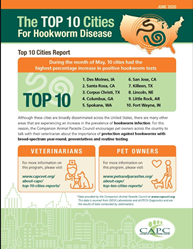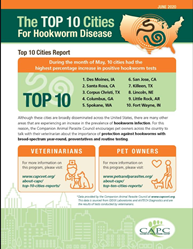
The Companion Animal Parasite Council — the nation’s leading source on parasitic diseases that threaten the health of pets and people — issued the CAPC Top 10 Cities Monthly HOOKWORM Report for May.
The recent outbreak of COVID-19, with its animal origin, has made people acutely aware of the close relationship between animal and human health — and the need to regularly monitor disease at the local level.
SALEM, Ore. (PRWEB)
June 16, 2020
The Companion Animal Parasite Council (CAPC) — the nation’s leading source on parasitic diseases that threaten the health of pets and people — today issued the CAPC Top 10 Cities Monthly HOOKWORM Report for May — with Des Moines topping the list as #1 across the country.
The new monthly report alerts pet parents, veterinarians and pet-related services about the emerging threat of hookworm — a zoonotic, parasitic disease threatening the health of both pets and people. The report identifies U.S. metro areas experiencing the highest percentage increase in positive hookworm tests in the last 30 days.
“The recent outbreak of COVID-19, with its animal origin, has made people acutely aware of the close relationship between animal and human health — and the need to regularly monitor disease at the local level,” said Dr. Chris Carpenter, DVM and CAPC’s Chief Executive Officer. “With the growing threat of hookworm, CAPC expands its decade-long mission to regularly monitor parasitic diseases in communities across the U.S. with its new CAPC Top 10 Cities Monthly HOOKWORM Report.”
Canine and feline hookworm can be lethal, particularly for puppies and kittens. In May, these 10 U.S. cities had the highest percentage increase in positive hookworm tests:
1) Des Moines, Iowa
2) Santa Rosa, California
3) Corpus Christi, Texas
4) Columbus, Georgia
5) Spokane, Washington
6) San Jose, California
7) Killeen, Texas
8) Lincoln, Nebraska
9) Little Rock, Arkansas
10) Fort Wayne, Indiana
“An increase in hookworm prevalence not only alerts communities to a heightened threat to the health of dogs and cats, but it also warns of an increased threat to the health of children and families who can potentially contract hookworm infection,” said Dr. Craig Prior, BVSC, CVJ, CAPC board member.
A recent study shows a 47% increase in the number of canine hookworm cases in the U.S. from 2012-2018 (Parasites & Vectors, 2019) — with CAPC maps reporting 212,863 positive cases of canine hookworm infections nationwide in 2018.
“This demonstrates how vital it is for dogs and cats to be protected against hookworm parasites with broad-spectrum, year-round preventatives and at a minimum bi-annual testing,” Prior added. “By protecting your pet, you are protecting other pets, your family, other families — and your entire community.”
What are hookworms?
Hookworms are parasites that live in contaminated soil and infect dogs and cats in all 50 states. Hookworm disease can cause debilitation or death, especially in puppies and kittens. Pets can become infected by hookworm larvae penetrating the skin, licking paws, chewing contaminated toys, or ingesting infected prey such as mice. Larvae migrate until they become adults in the intestines. Hookworm can also be transmitted from nursing mothers to puppies and kittens.
-
In dogs, signs of hookworm infection may include dark, tarry diarrhea, anemia, loss of appetite, weight loss and skin lesions. Puppies infected with hookworms are at greater risk due to blood loss. - In cats, signs of hookworm infection may include diarrhea or anemia. Respiratory disease and pneumonia may occur as larvae migrate through the lungs. In kittens, hookworms can be fatal due to blood loss.
- In people, hookworm infection is generally displayed on the skin with itching at the infection site and appears as cutaneous larval migrans — a winding, threadlike, raised rash. People should avoid walking barefoot in areas of potential contamination and wear gloves and shoes when gardening.
Contributing factors to increase in hookworm infection
Pets living in cities on this month’s CAPC Top 10 Cities HOOKWORM Report may have been exposed due to several risk factors, including environmental contamination from pet owners who don’t pick up dog stools, the growing popularity of dog parks, and pet owners’ noncompliance in administering year-round, broad-spectrum parasite control preventatives.
Environmental contamination in neighborhoods — and your own backyard
Hookworms produce a massive number of eggs on a daily basis, heightening the risk of environmental contamination. Any outdoor area where dogs and cats have access can become reservoirs of hookworm larvae. Typical areas of contamination include neighborhood streets, common areas, backyards, gardens, sandboxes, beaches and rest areas. Regularly removing feces is critical to preventing the spread of hookworms.
In communities across the country, dog owners not picking up their dog’s stool is a contentious issue — and for good reason. “Dog owners need to always pick up fecal waste in public areas — and at least once a week in their own backyards. If not, they are allowing hookworm larvae to live in the environment, and hookworm eggs are hearty with the ability to live for months.”
According to the U.S. Environmental Protection Agency, 40% of dog owners don’t pick up dog stool. “It’s more than a cosmetic issue,” Prior added.” Pet owners who are irresponsible in picking up after their dogs are putting the health of their own dog, other dogs — and the health of everyone in their community at risk.”
Growth of dog parks
Dog parks are quickly becoming a standard feature in many communities. A recent study by The Trust for Public Land reported 744 off-leash dog parks in the top 100 cities in the U.S. in 2018 — a 40% increase since 2009. “The popularity of dog parks is probably a major factor in the increased number of hookworm cases. Unlike boarding or day care facilities, dog parks don’t require proof of immunization and parasite protection,” Prior said. “And while dog parks provide a unique opportunity for dogs to exercise, it’s not uncommon for dog owners to socialize, and while not paying close attention — even for a few minutes — their dog defecates, leaving stool behind as a potential source of infection.”
All pets protected and tested
CAPC recommends that all dogs and cats be protected with monthly broad-spectrum parasite control with efficacy against hookworms year-round. CAPC also recommends puppies and kittens be tested at least four times in the first year of life for hookworms and other intestinal parasites; and at least two times per year in adults — even if they are on year-round preventives. To more closely pinpoint risk areas for hookworm, CAPC Parasite Prevalence Maps (http://www.capcvet.org) provide hookworm parasite prevalence in every county across the U.S.
“For nearly a decade, CAPC has been a national leader in monitoring parasitic diseases that threaten pets and people with timely, local disease prevalence maps,” Carpenter said. “It’s our hope that the new CAPC Top 10 Cities HOOKWORM Report will prompt important conversations between pet owners and their veterinarians about hookworm protection.”
ABOUT CAPC
The Companion Animal Parasite Council (http://www.capcvet.org) is an independent not-for-profit foundation comprised of parasitologists, veterinarians, medical, public health and other professionals that provides information for the optimal control of internal and external parasites that threaten the health of pets and people. Formed in 2002, CAPC works to help veterinary professionals and pet owners develop the best practices in parasite management that protect pets from parasitic infections and reduce the risk of zoonotic parasite transmission.

